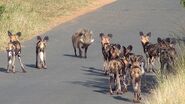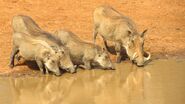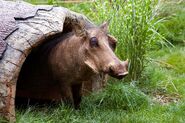
Common Warthog near Punda Maria, Kruger NP, SOUTH AFRICA
The warthog (Phacochoerus africanus) is the sole genus of subfamily Phacochoerinae. They are found in open and semiopen habitats, even in quite arid regions, in sub-Saharan Africa. The two species were formerly considered conspecific under the scientific name Phacochoerus aethiopicus, but today this is limited to the desert warthog, while the best-known and most widespread species, the common warthog (or simply warthog) is Phacochoerus africanus.
Although covered in bristly hairs, their bodies and heads appear largely naked from a distance, with only the crest along the back, and the tufts on their cheeks and tails being obviously haired. The English name refers to their facial wattles, which are particularly distinct in males. They also have very distinct tusks, which reach a length of 25.5 to 63.5 cm (10.0 to 25.0 in) in the males, but are always smaller in the females. They are largely herbivorous, but occasionally also eat small animal food. While both species remain fairly common and widespread, and therefore are considered to be of Least Concern by the IUCN, the nominate subspecies of the desert warthog, commonly known as the Cape warthog, became extinct around 1865.
Warthogs are members of the same family as domestic pigs, but present a much different appearance. These sturdy hogs are not among the world's most aesthetically pleasing animals—their large, flat heads are covered with "warts," which are actually protective bumps. Warthogs also sport four sharp tusks. They are mostly bald, but they do have some sparse hair and a thicker mane on their backs.
Though warthogs appear ferocious, they are basically grazers. They eat grasses and plants, and also use their snouts to dig or "root" for roots or bulbs. When startled or threatened, warthogs can be surprisingly fast, running at speeds of up to 30 miles (48 kilometers) an hour. Warthogs are adaptable and are able to go long periods without water, as much as several months in the dry season.
When water is available, warthogs will seek it and often submerge to cool down. They will also wallow in mud for the same purpose—and to gain relief from insects. Birds also aid these hogs in their battle with insects; oxpeckers and other species sometimes ride along on their warthog hosts, feeding on the tiny creatures invading their hides. These African hogs often utilize empty dens created by aardvarks. Rather than fight, they often choose flight, and search for such a den to use as a hidey-hole. They typically back in, using their tusks to effectively guard the entrance. Warthogs also use these dens to have their young. Females have litters of four or fewer young, which they suckle for about four months. Warthog families are called "sounders" and will often dig burrows by using their long flat snouts as shovels or sometimes move into vacant burrows dug by aardvarks.
It has also been notified by Martin and Chris Kratt that warthogs have a strange symbiotic realtionship with mongoose, who eat the bugs and dead skin off the warthog's body.




















